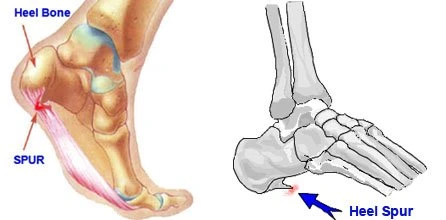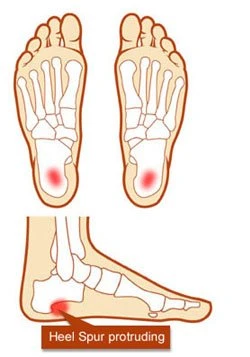Metatarsal stress fractures or a bone spur can cause pain at the top of the foot. A bone spur is an enlarged bone that looks like a bump on top of the foot. The bone spur is likely the result of too much pressure or too tight shoes.
The most common remedy for bone spurs involves wearing a larger size shoe and not tying shoelaces quite so tight so that you take some of the pressure off the bone. Remember, feet swell when running long distances. If you're a runner, you might want to cut a piece of foam rubber about ¼ tick to make a doughnut-shaped pad that will fit over the bone spur. Put it on before you run, or glue it to the tongue of your running shoe.
You can also reduce the pain of bone spurs by keeping your weight under control. You should also try to minimize the shock to the feet from constant pounding on hard surfaces. Choose footwear with some padding or shock-absorbing materials.
A bone spur or overgrowth that develops on top of the bone may prevent the bone from flexing as it should, especially when walking. This results to a stiff big toe also known as hallux rigidus.

Hallux rigidus commonly affects adults between 30 and 60. There are no good explanations as to why this condition happens to some and not others. But one theory suggests that hallux rigidus is the result of an injury to the toe that damages that articular cartilage.

The usual symptom of hallux rigidus is difficulty bending the toe up and down, especially when walking. This type of foot problem is easy to treat in its early stage. Waiting for the bone spur to appear on top of the foot will only make the condition more difficult to treat.
There are many non-surgical options for treating foot pain on the top of the foot. Using pain relievers and anti-inflammatory drugs such as ibuprofen can help to reduce the swelling and pain. Using ice packs or taking contrast baths may also reduce inflammation and control symptoms for short periods. These measures provide temporary relief, but are not enough to prevent the condition from developing further.
Wearing shoes with plenty of room at the toe may also help in reducing the pressure - and high heels are out I'm afraid. A shoe with a stiff sole, either with a rocker or roller bottom design and sometimes a steel shank or metal brace in the sole maybe required. For supporting the foot and reducing the bend of the big toe this type of shoe is excellent, especially when walking.
A contrast bath might also prove helpful. This technique involves putting your foot in first cold, then hot water to reduce inflammation. There are two buckets required, one bucket containing cold water and the other with hot water (at a tolerable temperature of course). Alternate between the cold and hot water for five minutes ending with a cold session. Surgical options may also be considered for severe foot problems.
If you think you have any of the foot problems discussed here, consult your own doctor for the treatments that will be best for your unique situation.
 |
 |
 |
 |
Great Ones for You